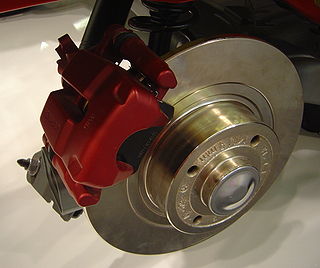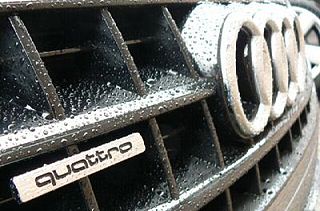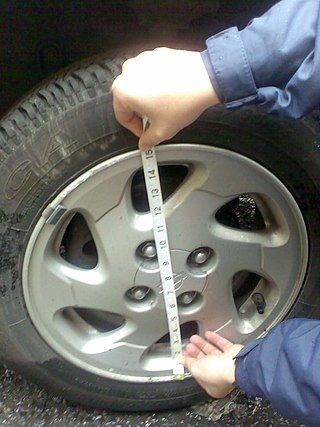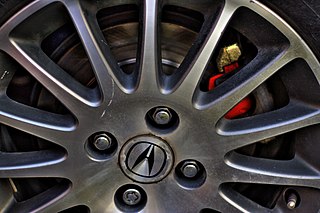
A wheel hub assembly (WHA), also referred to as hub assembly, wheel hub unit, wheel hub bearing , is an automotive part used in most cars, passenger vehicles, and light and heavy trucks.[ citation needed ]

A wheel hub assembly (WHA), also referred to as hub assembly, wheel hub unit, wheel hub bearing , is an automotive part used in most cars, passenger vehicles, and light and heavy trucks.[ citation needed ]
The hub assembly is located between the brake drums or discs and the drive axle. A wheel is bolted on it. Depending on the construction, the end of the hub comes equipped with the splined teeth. They mate the teeth on the axle shaft. The axle hub spins along with the wheels bolted to it and provide power to the wheels in order to rotate.
A roller bearing between the axle hub and axle shaft ensures easy rotation of the non-drive wheels. On the axle side, it is mounted to the holding bracket from the chassis; on the disc side, the wheel is mounted to the bolts of the WHA. When replacing, a wheel hub assembly should be torqued to the vehicle's specifications to prevent failure. [1]
Wheel hub bearing are used at least since the 1930s when SKF designed a unit used on the Citroën Traction Avant car. [2] As of 2019 at least 90 million vehicles use SKF wheel hub bearings. [2]

A disc brake is a type of brake that uses the calipers to squeeze pairs of pads against a disc or a rotor to create friction. There are two basic types of brake pad friction mechanisms: abrasive friction and adherent friction. This action slows the rotation of a shaft, such as a vehicle axle, either to reduce its rotational speed or to hold it stationary. The energy of motion is converted into heat, which must be dispersed.

An axle or axletree is a central shaft for a rotating wheel or gear. On wheeled vehicles, the axle may be fixed to the wheels, rotating with them, or fixed to the vehicle, with the wheels rotating around the axle. In the former case, bearings or bushings are provided at the mounting points where the axle is supported. In the latter case, a bearing or bushing sits inside a central hole in the wheel to allow the wheel or gear to rotate around the axle. Sometimes, especially on bicycles, the latter type of axle is referred to as a spindle.

A four-wheel drive, also called 4×4 or 4WD, is a two-axled vehicle drivetrain capable of providing torque to all of its wheels simultaneously. It may be full-time or on-demand, and is typically linked via a transfer case providing an additional output drive shaft and, in many instances, additional gear ranges.

A limited-slip differential (LSD) is a type of differential gear train that allows its two output shafts to rotate at different speeds but limits the maximum difference between the two shafts. Limited-slip differentials are often known by the generic trademark Positraction, a brand name owned by General Motors and originally used for its Chevrolet branded vehicles.

Quattro is the trademark used by the automotive brand Audi to indicate that all-wheel drive (AWD) technologies or systems are used on specific models of its automobiles.

In automotive design, a front-engine, front-wheel-drive (FWD) layout, or FF layout, places both the internal combustion engine and driven roadwheels at the front of the vehicle.

A caster is an undriven wheel that is designed to be attached to the bottom of a larger object to enable that object to be moved.

A transfer case is an intermediate gearbox that transfers power from the transmission of a motor vehicle to the driven axles of four-wheel-drive, all-wheel-drive, and other multi-axled on- and off-road machines. A part of the vehicle's drivetrain, it employs drive shafts to mechanically deliver motive power. The transfer case also synchronizes the difference between the rotation of the front and rear wheels, and may contain one or more sets of low range gears for off-road use.

The wheel size for a motor vehicle or similar wheel has a number of parameters.

A drive shaft, driveshaft, driving shaft, tailshaft, propeller shaft, or Cardan shaft is a component for transmitting mechanical power, torque, and rotation, usually used to connect other components of a drivetrain that cannot be connected directly because of distance or the need to allow for relative movement between them.

An inboard brake is an automobile technology wherein the disc brakes are mounted on the chassis of the vehicle, rather than directly on the wheel hubs. Its main advantages are twofold: a reduction in the unsprung weight of the wheel hubs, as this no longer includes the brake discs and calipers; and braking torque is applied directly to the chassis, rather than being transferred to it through the suspension arms.

A portal axle is an off-road vehicle suspension and drive technology where the axle tube or the half-shaft is offset from – usually above – the center of the wheel hub and where driving power is transferred to each wheel via a simple gearbox, built onto each hub. It gives two advantages: ground clearance is increased, particularly beneath the low-slung differential housing of the main axles — and secondly, any hub reduction gearing allows the axle half shafts to drive the same power but at reduced torque. This reduces load on the axle crown wheel and differential.

The Hotchkiss drive is a shaft drive form of power transmission. It was the dominant means for front-engine, rear-wheel drive layout cars in the 20th century. The name comes from the French automobile manufacturer Hotchkiss, although other makers, such as Peerless, used similar systems before Hotchkiss.
Torque steer is the unintended influence of engine torque on the steering, especially in front-wheel-drive vehicles. For example, during heavy acceleration, the steering may pull to one side, which may be disturbing to the driver. The effect is manifested either as a tugging sensation in the steering wheel, or a veering of the vehicle from the intended path. Torque steer is directly related to differences in the forces in the contact patches of the left and right drive wheels. The effect becomes more evident when high torques are applied to the drive wheels because of a high overall reduction ratio between the engine and wheels, high engine torque, or some combination of the two. Torque steer is distinct from steering kickback.

A beam axle, rigid axle or solid axle is a dependent suspension design in which a set of wheels is connected laterally by a single beam or shaft. Beam axles were once commonly used at the rear wheels of a vehicle, but historically they have also been used as front axles in four-wheel-drive vehicles. In most automobiles, beam axles have been replaced with front (IFS) and rear independent suspensions (IRS).

A lug nut or wheel nut is a fastener, specifically a nut, used to secure a wheel on a vehicle. Typically, lug nuts are found on automobiles, trucks (lorries), and other large vehicles using rubber tires.
The GM 10.5" 14-bolt differential stands as a robust drivetrain component extensively featured in Chevrolet and GMC trucks, SUVs, and vans from 1973 onward, including specific versions of the Cadillac Escalade. Introduced in 1973, this differential employs a full-floating design, boasting a substantial ring gear diameter measuring 10.5 inches. Its nomenclature, "14-bolt," represents the 14 bolts securing the differential cover, although the ring gear itself is fastened by 12 bolts. Notably, the 14-bolt differential gained traction among Jeep Wrangler owners seeking axle replacement options, earning the moniker "corporate" 14-bolt because of its association with GM's corporate structure during the 1970s.

Jaguar's independent rear suspension (IRS) unit has been a common component of a number of Jaguar production cars since 1961, passing through two major changes of configuration up to 2006 and last used in the Jaguar XK8 and Aston Martin DB7. This article concentrates on the first generation Jaguar IRS, which firmly established the marque's reputation for suspension sophistication, combining as it did smooth ride with excellent roadholding and low levels of noise, vibration, and harshness (NVH). The two generations overlap in time due to their being used in both full size and sports models that were updated at different times.

An H-drive drivetrain is a system used for heavy off-road vehicles with 6×6 or 8×8 drive to supply power to each wheel station.